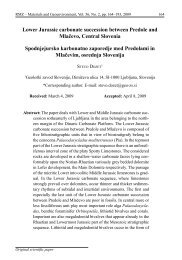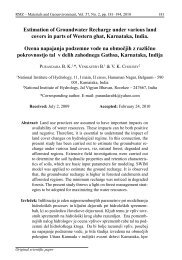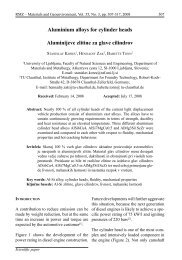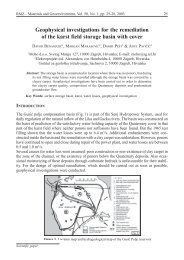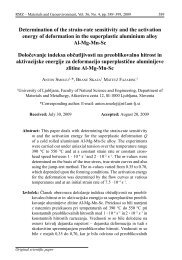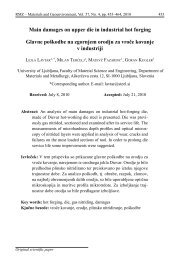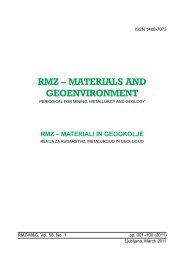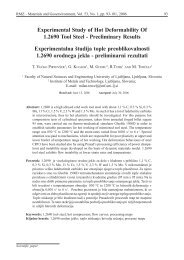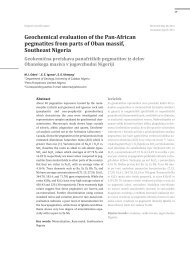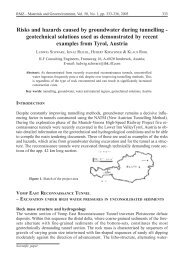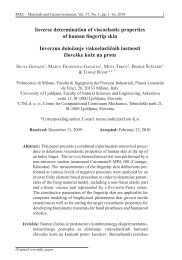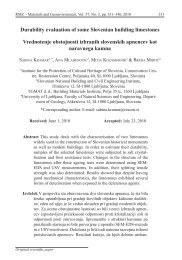RMZ â MATERIALI IN GEOOKOLJE
RMZ â MATERIALI IN GEOOKOLJE
RMZ â MATERIALI IN GEOOKOLJE
- No tags were found...
Create successful ePaper yourself
Turn your PDF publications into a flip-book with our unique Google optimized e-Paper software.
424 Adewale, A., Olawale, O. O., Martins, O. M.Figures 4 and 5 present the ERT rawdata, calculated pseudosection and 2-dinverted resistivity data across the fieldalong the E-W profile. The plot alsodelineates the high resistivity layer tobe tar impregnated. This agrees withVES results and borehole information.Sedimentological Analyses ResultsThe mechanical sieve analysis gave anaverage grain size distribution of thereservoir sand to range from ф = 0.03–0.55 mm, which indicates a medium tocoarse sands. The skewness of the reservoirsand was determined to rangesfrom –0.58–0.47, indicating stronglycoarse to strongly fine skewed according(Folk, 1974). This result definesa high energy of deposition at Ebute,Shofini and Bakue, but lower at Gbegude,thus accounting for the 2.5 % offines in its composition. The sortingof the reservoir sands ranges in valuesfrom ф = 0.82 mm (moderately sorted)to ф = 1.63 mm (poorly sorted) accordingto Folks`1974 classification, whilethe percentage of fines collected werecomposed of silt and kaolinitic claysin the range of 1–3 %. The summaryof the granulometric analyses results ispresented in table 2.Depth of occurrence of the tar sanddeposits affects the volume of voidsas well as the precipitation of bitumenduring migration by fines due to geopetalaccumulation (Lomando, 1986and 1992; Dutton & Finley, 1988)which has the tendency to result in areduction of pore throats and porosity.The moderate to high porosity valuesobtained for the reservoir sands, whichrange from 16–24 %, (Cole & Christopher,1992; Wallace & John, 1992, Lomando,1992). The interconnectivity ofpore spaces to transmit fluid is howeverobstructed by the precipitation of finesfrom migrating fluids which reducedthe pore throats. In addition, the degreeof sorting as well as the measure ofskewness also affects the degree of reservoir’spermeability. This is because astrongly coarse skewed reservoir sandsis expected to have larger pore throats,which if interconnected is expected tobe highly permeable. The permeabilitymay be reduced however where thepore throats are blocked by fines in caseof poorly sorted reservoir sands. Mostof the reservoir sands are moderatelysorted, which is a good reservoir quality.Permeability is also dependent onthe effective grain size of the reservoirsand (Schlumberger, 1989). It can bestated from this study that the larger theeffective grain size, the greater the permeabilityas evident in Table 3. Moreso, the presence or abundance of finesin a reservoir reduces the permeabilityof the reservoir. This was observed inthe analyzed samples. It was observedthat the poorly sorted reservoir sand atGbegude with about 2.5 % of fines recordthe lowest permeability value of143 mD. While the reservoir at Ebute<strong>RMZ</strong>-M&G 2012, 59



